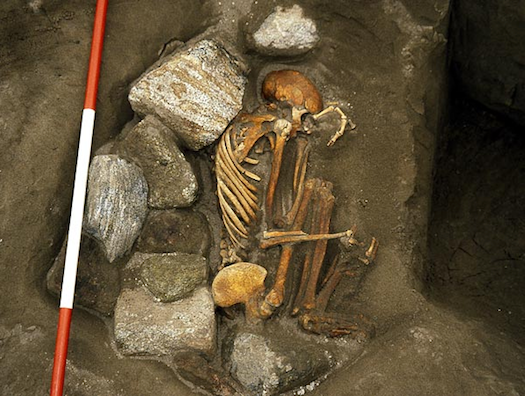Scientific studies do a pretty good job of answering questions about how the world works. But often, researchers are pursuing things we never thought of as worth pursuing. Here we salute those tireless journeymen that have looked into the depths of our history and found the answers to things we never knew we were wondering.
What Alexander Graham Bell’s Voice Sounded Like
We now know what the man who made it possible to hear the voices of cross-country friends sounded like. Alexander Graham Bell, the inventor most notable for his invention of the telephone and other sound recording methods, has himself been silent in the annals of history, but thanks to the Smithsonian’s National Museum of American History in collaboration with the Library of Congress and the Lawrence Berkeley National Lab, researchers have identified Bell’s voice. The audio recordings come from Bell’s Volta lab, and they are some of the earliest ever made. Researchers discovered a transcript of a recording, which was signed and dated by Bell. Recently, researchers matched this transcript with a recording dated April 15, 1885. The recording sounds as old as it is, and Bell spends about 4 minutes reading numbers aloud, signing off with “in witness whereof, hear my voice, Alexander Graham Bell.” The noninvasive optical technique that was used to recover the sound is a method that has been developed over the past 10 years. The team is still recovering sound from the Volta lab discs with hopes to shed light on the innovation process.
The Color Of Abraham Lincoln’s Funeral Car
Abraham Lincoln’s 1865 funeral included a two-week train procession across the northern states of America. But given the use of black-and-white photography at the time, no one quite knew what color Lincoln’s funeral train car was–and with the 150th anniversary of his death looming, people were starting to wonder. Well, wonder no more. Researchers at the University of Arizona teamed up with model train builders to figure out exactly what color replicas should be painted. Newspaper clippings provided some clue, but were vague and meanings could have changed over time. And since the car burned in a fire in 1911, it’s been difficult to tell for sure. But one UA chemist and model train enthusiast, Wayne Wesolowski obtained a small piece of trim from the rail car. After comparing microscopic paint chips from the car to national color standards, the true original color was revealed–a dark maroon.
The Kind Of Paint Picasso Used
The Art Institute of Chicago and the Argonne National Lab have teamed up to determine what kind paint is behind the famous pictures. The results were published in Applied Physics A: Materials Science & Processing and add to the theory that Picasso was one of the first to use common house paint rather than artists’ paint. To figure this out, scientists used a high-energy X-ray to get a close-up view of the chemical elements of a material, leading to the discovery that Picasso’s paint matched the chemical makeup of Ripolin, the first commercially-available house paint.
What Ancient Earth Smelled Like
Ever ponder what the earth could have smelled like 1.9 billion years ago? Scientists may have uncovered the ancient stench based on fossils found around Lake Superior in Canada. A team of researchers has published a report in this week’s Proceedings of the National Academy of Sciences that show fossil evidence of how ancient microbes feasted on Gunflinitia, a cyanobacterium-like fossil, a type of feeding called hetereotrophy. “What we call ‘heterotrophy’ is the same thing we do after dinner as bacteria in our gut break down organic matter,” said one of the paper’s authors and Oxford Professor Martin Brasier in a statement. This, in fact, is not very different from modern bacteria feeding, emitting a tell-tale smell of hydrogen sulfide–in other words, the stench of rotten eggs. “So rather surprisingly, we can say that life on earth 1,900 million years ago would have smelled a lot like rotten eggs,” Brasier said.
The age of the oldest toothache
Back in 2011, scientists at University of Toronto Mississauga found evidence of an oral infection in Paleozoic reptiles that lived 275 million years ago. This blew the previous record of oral and dental disease in terrestrial vertebrates out of the water by almost 200 million years–because of course there’s a record for that. These unfortunate specimens of Labidosaurus hamatus must have faced some unfortunate toothaches as they adapted to living on land and feeding on both meat and plants. Researchers used CT-scans to locate the massive infection, which led to bone destruction in the jaw and the loss of teeth.
The Existence Of A Franken-Mummy
Is there really a franken-mummy? Well, not quite… but scientists last summer found that 3,000-year-old bog bodies were basically mummified Frankensteins. These two bodies–one male and one female–were probably placed in a peat bog to preserve them, and were re-buried hundreds of years later. Scientists realized the female skeleton’s jaw didn’t fit with the rest of the skull, and after some DNA testing, they found that the bones had come from different people. In the case of the male skeleton, the parts were from people who lived hundreds of years apart. The reason for this human puzzle is unclear, but study author Terry Brown posited the cynical possibility that “the head dropped off and they got another head to stick on.”






